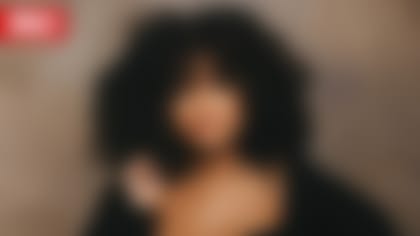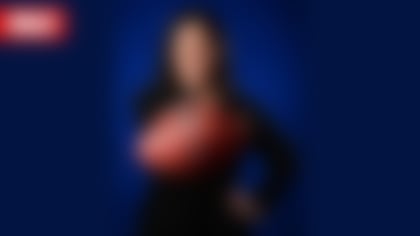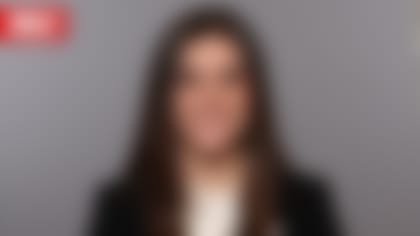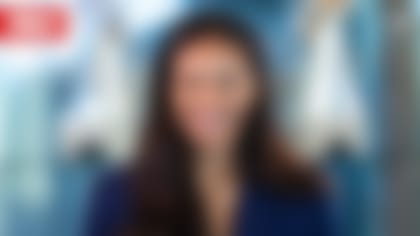Women are rising up the ranks throughout professional football, earning positions of power in a space that for too long was ruled almost exclusively by men. We're seeing more and more women breaking barriers in the sport, but what are the stories beyond the headlines? Who are the women shaping and influencing the NFL today? Answering those questions is the aim of the Next Woman Up series. While the conversational Q&As are edited and condensed for clarity, this is a forum for impactful women to share experiences in their own words. Without further ado, we introduce:
Donny Brock, Seattle Seahawks
Position: Marketing Design Manager
Let's start at the beginning. How did you get your start in a career in football?
I didn't necessarily set out to work in sports. I have always wanted to work in the music industry, and I always dreamed of creating a platinum album cover for Kendrick Lamar or a big artist. But in 2018, I applied for an internship with the Houston Rockets. I interviewed and got the position, so that was my introduction into sports. Through that opportunity, I was able to see the impact sports could have on culture in the community, and I was able to articulate my creativity in new ways.
While I was with the Rockets, I was also working with an oil and gas company. After the internship with the Rockets, I went back to the company and they hired me in a newly created role as sort of an art director because I thought I could really make an impact there. When the pandemic hit, I accepted a freelance role as a graphic designer with the Houston Texans for one season, before getting my first big-girl job as an art director with an agency called M2, which worked with the Texans through a partnership.
I then had declined a few job offers in sports before coming to the Seahawks because I was waiting for that lightning-strike moment. One day, I got a message from Seahawks creative director John Weaver saying they were hiring for this position. They saw my portfolio and liked my work. I knew immediately that this was the next step. Our team is made up of a lot of women, and I like to challenge people when they ask me about being in a male-dominated space, because a majority of things that people see in regard to Seahawks branding, marketing, graphics, etc., is made by a woman. It really makes them reconsider.
And what exactly does your job entail?
As a design manager, I essentially am the creative eyeball of the Seahawks. Everything you see on social media to our larger campaigns -- training camp, schedule release, Pro Bowl -- are all things I work on, and that spans across logo creation to print production. This year, I have been able to take on more of an art director approach to my work. I am in the room when we're talking about the Seahawks' voice and tone and crossing the lines between marketing and design.
The NFL schedule release has become a huge event for marketing and social teams. Did you play a role in the Seahawks' schedule release execution?
I actually came up with the concept of the schedule-release theme -- “Scheduleverse” -- and the overall direction of it. Our initial planning meeting was I believe about 90 days before the schedule release. We settled on the idea two months before, and it was a well-thought-out process. I pitched the idea and the social department chewed on it for a bit. There were a couple of other strong ideas, and we basically had a UFC-level debate. It was so exciting watching people get so passionate about the themes. After we narrowed down the "Scheduleverse", it was a collaborative effort. We collaborated with some local artists for our comic book covers, finding different ways to give platforms to smaller creatives in the community. It was really diverse as we featured a Play-Doh artist, AI artist, traditional comic book artist and others.

I am really proud it. Every project or campaign that we do, I take as an opportunity to change the game, to challenge us as a franchise to reach new communities. I really wanted to do that with this one, and I know going into the "Spider-Verse" resonates with people for different reasons.
I had to find my voice in order to do help my team with the schedule release, which was really challenging. I always say that having a seat at the table doesn't always give you a voice at the table. So once I was at the table in those meetings, I wanted to bring another voice with me. Meghan Skapyak and Christine You are young women in our organization who have all of these ideas for the schedule release. I encouraged them to speak up to the larger group, and I'm proud of myself for locking arms with others to help get them in that space.
Did you have a favorite comic book cover?
Yes, it was the “Riq da Freak” cover by Jake Larsen. He is someone I have admired for a long time, and I've followed him since the start of my career. Getting to work with him was so dope, and his cover was sick. The players saw their covers and I think that one got the biggest reaction. At the end of the day, getting the players excited about this campaign was super cool because I think people forget to keep the players top of mind.
What a unique theme for the schedule release, and it looked like such a fun project to be part of. When you consider your role, what would you say is the most challenging part of it?
Understanding the crossover between self-care and my ability to do my job. I think a lot of people feel like they have to abandon themselves to show up for work. I feel like when you take care of yourself, you are taking care of the work that you do. My biggest priority has been holding myself accountable to being proactive about creative block. Sometimes I need to shut my laptop and go to a museum or help out in my community. All of what I learn outside of work, I bring it back. I constantly try to remind myself of that in a world and industry that is fast-paced, where you feel like you're going to miss something if you take a step away.
I know you have been in your role for just over two years, but do you have a favorite moment from your time with the Seahawks?
Karen Wilkins-Mickey, the Seahawks VP of diversity, equity and inclusion, created this safe space for BIPOC (Black, Indigenous and People of Color) employees. She advocated for us to have this civil rights tour with Common Power to the South. There were beautiful moments and I learned so much. One of the things that softened me was I created a "Truth and Purpose tour" T-shirt, and one of the foot soldiers, Charles Mauldin, who walked across the Edmund Pettus Bridge in Selma, Alabama, with Martin Luther King Jr., wore my T-shirt. He was talking to our group on that bridge, and I could've never imagined an NFL team bringing this moment to me in this way. It completely changed my life in a lot of different ways.
I am a designer, but I am an artist first. That moment made me realize that my gift does not belong to me. It belongs to my community and the world. One of the questions we were asked on that tour was "What are you going to do to make an impact?" It really made me think about how I can use my gift.
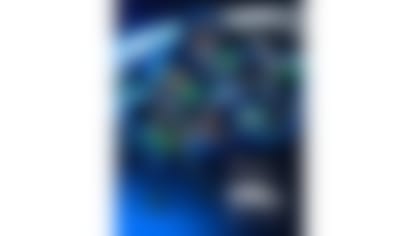
That sounds like such an impactful experience. Do you have any mentors who have helped you along the way? If so, what advice have you received from them?
We have an amazing organization and I've met so many great people. We have a group of Black women here who do lunch together, and I met Marissa John, the Seahawks director of legal affairs, in this group. The best advice she's given me was actually during the schedule release process. I had this feeling that if the idea for the "Scheduleverse" came from me, that people wouldn't listen or take it seriously.
I decided that during a meeting I was going to just listen, take it all in, and ask my creative director, John, to advocate for me -- he did and I appreciate him so much for doing that. However, she told me not to quiet my voice so people won't hear me and said that I needed to create a space to advocate for myself and learn how to do that. She said that my voice is important on its own.
She told me to not leave those meetings until I said what I needed to say. She told me to tell my creative director: Thank you for advocating for me but to also give me the space to advocate for myself and learn how to do that.
And what advice do you have for other women looking to get into a career in football?
Be authentic. The power you have is your authenticity, story and lens. That is your cape in the 100 mph wind of this industry. The one thing no one else can have is who you are. Embracing that isn't something to be ashamed of.
That is some great advice. What is next for you in terms of what you want to accomplish?
I think I have had an impact locally in this role, but I want to expand that and have a global impact. I would love to have people who don't look like me or speak the same language as me to feel empowered by what I do. I want to challenge narratives that have existed for way too long when it comes to marginalized communities. For little Black girls who want to work in sports like I do to have it so much better.
Lastly, what are you most proud of in your career so far?
I'm most proud of the impact. I think the things we do here touch a lot of people, some of whom we may never meet. I can feel that impact. As long as I create in ways that are of service to my culture and community, I will continue to have that kind of impact. I never do my work for the outcome, I do it because it matters. But the outcome is so sweet when you see others feel empowered and seen.

